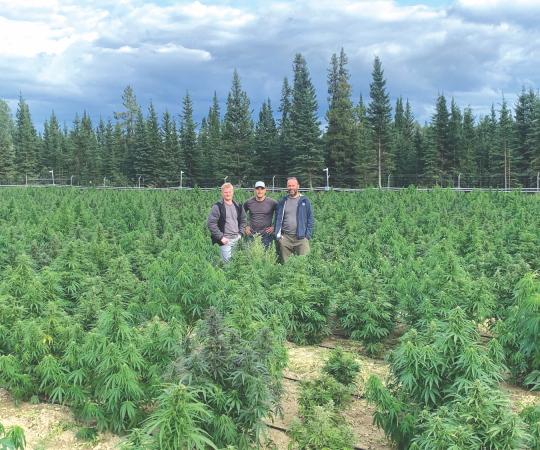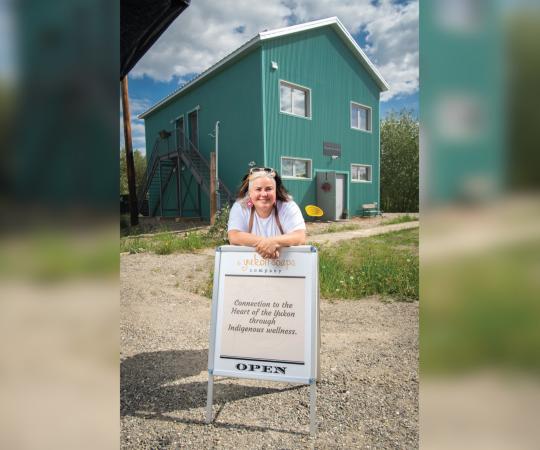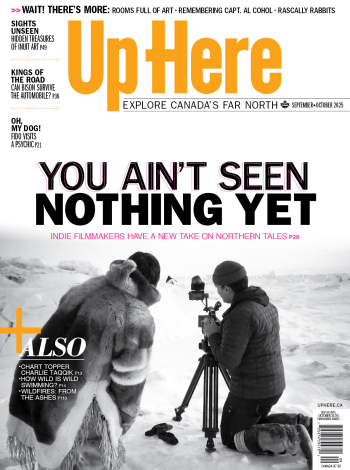Adrian Hollis has been mining his patch of ground in the Klondike for 20 years now. Originally from Australia, the 64-year-old came to the Yukon by way of Papua New Guinea and Venezuela. “I was always involved in the heavy equipment business,” he says, “so me and placer mining were very much made for each other.”
He started out as a driller, hiring himself and his drill out on contract before eventually buying up an unwanted property from another miner. “Lo and behold,” he says, “I found quite a bit of gold, so I was very happy.”
His mine is on Dominion Creek, 70 kilometres from Dawson City, and he works the ground there with two other people from April to mid-October each year, venturing back into Dawson for groceries once a week.
“Never see a traffic light from the time I leave Whitehorse in the spring until I get back there in the fall,” he says. “I like it that way.”
Placer (pronounced plasser) gold is free gold—that is, it’s not trapped in the bedrock. After being gradually weathered out, according to Jeff Bond, the manager of surficial geology at the Yukon Geological Survey, those gold fragments have migrated naturally downhill and then wound up in valley bottoms and streambeds. It’s placer gold that the stampeders of 1898 were going after.
But placer mining is much more than a relic of the territory’s gold rush past. Bond estimates there are around 160 placer mines like Hollis’s still operating in the Yukon today, with more properties in various stages of exploration. A placer “mine,” of course, doesn’t look much like what you picture as a major hard-rock drilling operation: there are no underground tunnels, no masses of workers on around-the-clock shifts, and no billion-dollar backers.
“You go to town with your bag of gold. They’ll weigh it, they know the purity, they’ll give you the cash so you can go buy more fuel and groceries.”
Placer mines range from a single individual up to a crew of maybe 20 or so. But the average mine, according to Bond, is kept humming along by just three or four people. Often, they’re family-run operations—they might, in fact, be more analogous to a small family farm than to a typical mine. “The manager is also the miner, the cook might be a spouse or an operator as well—there’s definitely multiple hats being worn.”
In the old days, it was all about the lone miner with his gold pan. (There are still a smattering of traditional hand-miners operating in the Yukon today.) Then came the age of the giant gold dredges, chewing up the valleys through the first half of the 20th century, leaving tailings piles that still surround Dawson City today. Most modern placer miners use methods that fall somewhere between the simplicity of a pan and the power of a dredge.
The basic process remains the same: dig down to bedrock, remove the paydirt, and wash it to separate the gold from the rest. “It’s very simple technology, and it probably goes back literally thousands of years,” says Bond. Today, “in terms of the extraction process, it’s about using an excavator, it’s about using a bulldozer, your loader, your common sort of heavy equipment, and your trucks for hauling.”
Miners use their heavy equipment to dig up the (hopefully!) gold-bearing earth and feed it into a sluice box—that’s the device that helps miners use flowing water to separate the heavy gold fragments from all the other, lighter material they’re mixed in with. Although there are several types of sluice boxes, the basic concept remains the same, but the efficiency has improved: while a gold rush miner might have been able to wash a quarter of a cubic yard of paydirt per hour on a good day, today’s placer miners can wash 45 to 60 cubic metres per hour.
“We work a 12-hour shift, so there’s no time for reading. When you’ve got spare time off you just want to look at the back of your eyelids.”
Once they’ve got their gold dust, miners will generally refine it using a variety of techniques. Then they’ll typically pour it into gold bars—yep, that part is still DIY, even today—and bring it to the market.
“You go to town with your bag of gold”—usually Whitehorse or Dawson City, where the buyers are—“they’ll weigh it, they know the purity, they’ll give you the cash so you can go buy more fuel and groceries,” says Bond.
There’s a perception that gold miners must be getting rich, but really, margins in placer mining can be pretty slim. Buyers take a percentage for their services. And the logistics of the whole operation are costly, too. Some properties are reachable via old mining roads, but many are barge-in or even fly-in only, or require the construction of an annual winter road. None of the options come cheap, and heavy equipment is also expensive to purchase, operate, and maintain. And the gold doesn’t always want to be found. “The reality is it’s a good living for a lot of people,” Bond says, “but it’s not necessarily highly lucrative, either.” Although, “if you scale it up, you get the right ground, it can be.”
But it’s constant work. When asked what Hollis does to pass the time on the mine site, when he’s not working—read books? Make conversation?—he scoffs. “We work a 12-hour shift, so there’s no time for reading. When you’ve got spare time off you just want to look at the back of your eyelids,” he says. “You make your money in the summer. We don’t come here to talk, we come here to work.”
The hardest thing about placer mining, according to Hollis, is “getting out of bed at the end of the season … You’re glad to see it come to an end, but in the springtime you’re always glad to get back up here.”
And times are pretty good for most placer miners right now. Diesel costs are down, which helps their overhead, and with the price of gold pegged to the U.S. dollar, a weak loonie actually gives placer miners a boost: a gold price sitting around U.S. $1,100 per ounce becomes $1,400 or $1,500 Canadian, in today’s market.
Production is “holding steady,” says Bond, or maybe even climbing a little: placer miners in the territory produced 60,000 ounces of gold last year and again the year before (compared to roughly 47,000 in 2011 and 53,000 in 2012), and a similar output is expected this year. So if you ever fantasized about giving mining a shot, now might be the perfect time.
As for Hollis? When he’s not hard at work in the Klondike, he divides his winters between New Zealand and Thailand. “Life’s good.”










